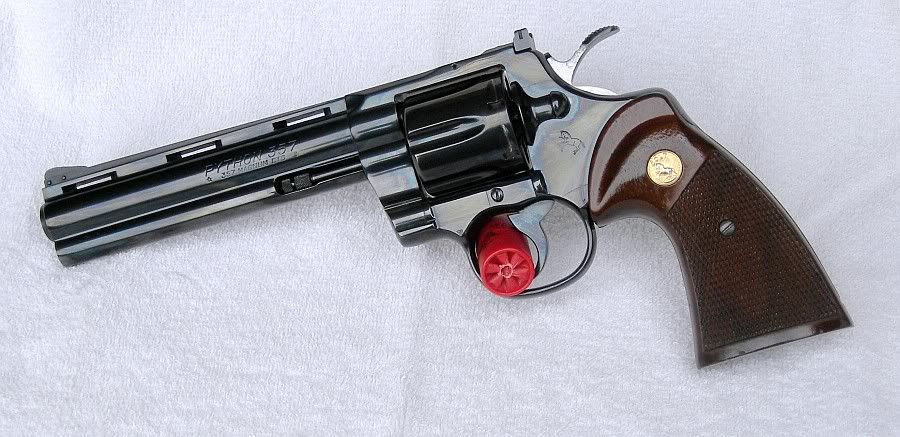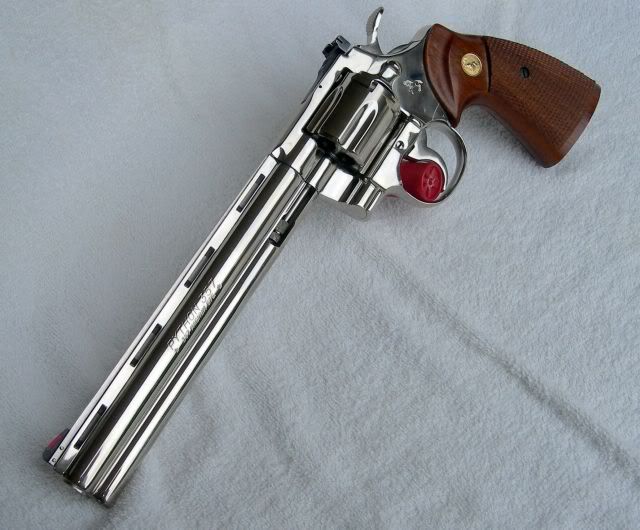You are using an out of date browser. It may not display this or other websites correctly.
You should upgrade or use an alternative browser.
You should upgrade or use an alternative browser.
I like shiney! On a quest for the best polish on a blued or stainless gun
- Thread starter Skans
- Start date
Mosin-Marauder
New member
For stainless I use Metal-Glo. Pretty much Flitz Metal Polish. A Mild abrasive that really brings out the shine in stainless. For Bluing,I use Rig or Waffenfett, they're both the same thing, pretty much any thick yellow grease will work. Don't have any pictures At the Moment, but will try to upload some later.
I do not care for shiny guns!!!But,thats OK,you may have your preferences,no problem.
If I were to put a high luster finish on a firearm,
I would use the technique I used to polish mold cavities and cores.
I can't teach it here,of course,but I would use a DME profiling tool ,which reciprocates 0 to 10,000 strokes per minute.I would use "puddle" stones,created by putting graded grit in water,to settle as sediment,which is then fired,and diamond sawed.Small pieces are broken off,shaped,and allowed to float on the surface,like a dust mop head.The stones are soft,and conform.
From there,a progression of brush,and two grades of felt are used with diamond compound.Fuel oil or alchohol are used as lubes.
I was taught by an old Master who was polishing dies for the Mint to strike coins when I showed up.
He put me to work on some cavities to make spray paint can tops.
I can tell you his methods yield bright mirror surfaces that you can look at for optical distortion of reflected images,and they are good.
I was assigned to polish some carbide mirrors once.They went in a satellite,to transmit optical signals.Flatness tolerance was called out .0001 over surface.Itold the shop owner he did not have metrology tools to measure that.
He said do what you can..
I brought in my own diamond compound and used .001 brass shim stock on a granite surface plate.
I cannot say I met spec,as I could not measure it.Our customer was delighted,and said they were the best optically they had ever been able to procure.
Thing is,supplies are expensive,and it takes time.
If you are paying $100 an hour flat rate and a man puts 8 hrs into a 1911 slide,pretty pricey.Not so bad,in a mold cavity,edm fin to high polish.Molds cost more than guns.
The smith needs higher production methods,and those have developed over time with different Masters.
I'll offer one trick that works really well on guns.Brownells sells a product,I don't recall the name.Its a grit and glue mix,a thick mix in a can.
Bandsaw and belt grind wooden tools,hard maple,to suit your job.Dip them in the grit,hang to dry.
Clean ,uniform grit,does not scratch.Reduces to conform and stay sharp.
Very versatile,for slow wood or leather wheels,etc.Try a can of 400 grit or so,maybe $25.See how it works for you.
Something I have not tried,but I just dreamed up...I have been looking at some fine Japanese chef's cutlery.Pursuing that,I found suppliers for Japanese water stones.Some of these are available as smaller pieces,or the may be sawed with a tile or glass saw.
Just a mental cartoon,but I think a 400 grit chunk of water stone might work very well on the side of a receiver flat receiver or a slide.
Buffing up a perfect 400 or 600 grit surface is not a problem.
There are cutting media that are hard..have their own shape.These do not wash out detail ,they only cut on the high plateau.
You can only do good polish by bringing te entire surface down to the bottom of the lowest scratches or flaws,without altering the geometry of the surface.Flat must remain flat,highlights must remain straight.
If you want good results,you cannot use soft media,like buffs,to wash out scratches or flaws.
You only use soft media on a surface you only want to shine up a bit.
If I were to put a high luster finish on a firearm,
I would use the technique I used to polish mold cavities and cores.
I can't teach it here,of course,but I would use a DME profiling tool ,which reciprocates 0 to 10,000 strokes per minute.I would use "puddle" stones,created by putting graded grit in water,to settle as sediment,which is then fired,and diamond sawed.Small pieces are broken off,shaped,and allowed to float on the surface,like a dust mop head.The stones are soft,and conform.
From there,a progression of brush,and two grades of felt are used with diamond compound.Fuel oil or alchohol are used as lubes.
I was taught by an old Master who was polishing dies for the Mint to strike coins when I showed up.
He put me to work on some cavities to make spray paint can tops.
I can tell you his methods yield bright mirror surfaces that you can look at for optical distortion of reflected images,and they are good.
I was assigned to polish some carbide mirrors once.They went in a satellite,to transmit optical signals.Flatness tolerance was called out .0001 over surface.Itold the shop owner he did not have metrology tools to measure that.
He said do what you can..
I brought in my own diamond compound and used .001 brass shim stock on a granite surface plate.
I cannot say I met spec,as I could not measure it.Our customer was delighted,and said they were the best optically they had ever been able to procure.
Thing is,supplies are expensive,and it takes time.
If you are paying $100 an hour flat rate and a man puts 8 hrs into a 1911 slide,pretty pricey.Not so bad,in a mold cavity,edm fin to high polish.Molds cost more than guns.
The smith needs higher production methods,and those have developed over time with different Masters.
I'll offer one trick that works really well on guns.Brownells sells a product,I don't recall the name.Its a grit and glue mix,a thick mix in a can.
Bandsaw and belt grind wooden tools,hard maple,to suit your job.Dip them in the grit,hang to dry.
Clean ,uniform grit,does not scratch.Reduces to conform and stay sharp.
Very versatile,for slow wood or leather wheels,etc.Try a can of 400 grit or so,maybe $25.See how it works for you.
Something I have not tried,but I just dreamed up...I have been looking at some fine Japanese chef's cutlery.Pursuing that,I found suppliers for Japanese water stones.Some of these are available as smaller pieces,or the may be sawed with a tile or glass saw.
Just a mental cartoon,but I think a 400 grit chunk of water stone might work very well on the side of a receiver flat receiver or a slide.
Buffing up a perfect 400 or 600 grit surface is not a problem.
There are cutting media that are hard..have their own shape.These do not wash out detail ,they only cut on the high plateau.
You can only do good polish by bringing te entire surface down to the bottom of the lowest scratches or flaws,without altering the geometry of the surface.Flat must remain flat,highlights must remain straight.
If you want good results,you cannot use soft media,like buffs,to wash out scratches or flaws.
You only use soft media on a surface you only want to shine up a bit.
Last edited:
HiBC, that was a very interesting read. I'd love to see you do your magic on a nice firearm.
I have examined under a loop, two pythons, a Belgian Hi-Power, a CZ 75B Glossy blue and a Colt Gold Cup Trophy with the Ultimate mirror polish in stainless. The Gold Cup wins hands down for best finish. Then the Pythons. The '71 Hi-Power is not really even a glossy blue finish - beautiful in its own, but not glossy. The CZ 75B is shiny and beautiful from about a foot, but when you look at it with a loop, you can see swirls and polishing marks.
I'd really like to get that CZ to a true mirror polish and then have a real nice hot blue job done on it. Not worth it, I know - just enjoy it for what it is. It's still a beautiful gun.
I have examined under a loop, two pythons, a Belgian Hi-Power, a CZ 75B Glossy blue and a Colt Gold Cup Trophy with the Ultimate mirror polish in stainless. The Gold Cup wins hands down for best finish. Then the Pythons. The '71 Hi-Power is not really even a glossy blue finish - beautiful in its own, but not glossy. The CZ 75B is shiny and beautiful from about a foot, but when you look at it with a loop, you can see swirls and polishing marks.
I'd really like to get that CZ to a true mirror polish and then have a real nice hot blue job done on it. Not worth it, I know - just enjoy it for what it is. It's still a beautiful gun.
Crankgrinder
New member
most people who polish metal use a loose wheel and jewlers roughe
For nickel and stainless finishes, you can try some Mother's Mag & Aluminum Polish. Works for me. I pretty much like a miracle cloth after applying CLP as a cleaner lubricant on blued firearms.
Simichrome Polish also works on some stubborn spots but should not used on blued surfaces.
Simichrome Polish also works on some stubborn spots but should not used on blued surfaces.



